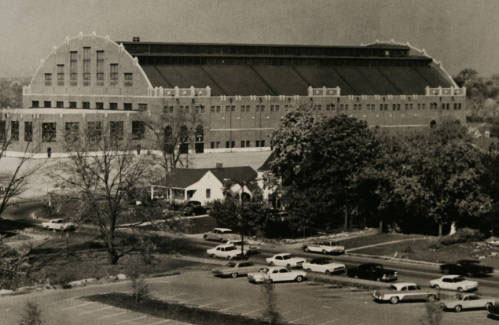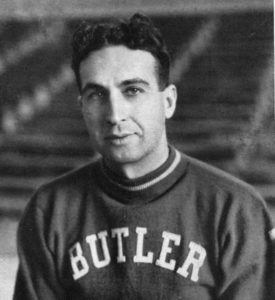
Construction began in 1926 on Arthur Jordan Hall and the Butler Fieldhouse (renamed Hinkle Fieldhouse after coach Paul “Tony” Hinkle in 1966). Classes began in the fall of 1928. Jordan Hall, designed in the Collegiate Gothic style by Robert Frost Daggett and Thomas Hibben, housed the classrooms and offices; it still anchors the campus today. Both are on the National Historic Register. Ca. 1950s Digital Image 2011 Butler University. All Rights Reserved.
Nation’s oldest college basketball arena that takes the nickname “Indiana’s Basketball Cathedral”
The construction of Butler (later Hinkle) Fieldhouse in 1928 thrust Butler University’s basketball team and its coach Paul D. “Tony” Hinkle, into the national spotlight. Along with Madison Square Garden, the 15,000-seat fieldhouse was considered the nation’s premier basketball venue, and the fieldhouse served as the nation’s largest basketball venue until 1950.
The mystique of the large structure attracted defending national champion Notre Dame to play Butler, with the Bulldogs’ subsequent victory in the building’s inaugural game propelling them to the 1928 national championship. Over time, the destination remained the same, but the arena was renamed Hinkle Fieldhouse after 1965 in honor of legendary Butler coach Paul Hinkle.
The fieldhouse, designed by Indianapolis architect Fermor Spencer Cannon, served as a prototype for other large indoor athletic complexes. The brick structure is six stories high and covers over three acres. Its innovative construction techniques, such as an arched steel truss system that supports the roof, allows spectators to view events unobstructed by posts or pillars. Butler Fieldhouse was also the first arena to employ a ramp system to get people to upper-level seating. The original basketball court ran east and west. This design was changed in 1933 to provide more seating and because athletes complained about facing the late afternoon sun when attacking the western basket.
The building quickly became the focal point for high school basketball in Indiana. The Indiana High School Athletic Association held its annual basketball championships there beginning in 1928, and Butler Fieldhouse became a coveted destination as “Hoosier Hysteria” swept through small towns throughout the state every March.
One such notable event came in the 1950s when Hinkle saw the Crispus Attucks basketball team became the first all-black high school team to win back-to-back high school championships in 1955 and 1956. Just a year prior, the stadium also hosted the game known as the “Milan Miracle” which went on to inspire the movie “Hoosiers.”
Eventually, the IHSAA moved its basketball tournament finals from Hinkle to Indiana University’s Assembly Hall in 1972 (and later to other sites), but the fieldhouse continued to host sectional play through 1993. The IHSAA’s decision to move the sectional to Lawrence North High School in 1994 ended Hinkle Fieldhouse’s long association with IHSAA basketball.
Aside from basketball, the fieldhouse has hosted numerous important athletic, religious, political, and entertainment events, including the Butler Relays of the 1930s and 1940s, professional tennis tours, and circuses. It also served as a convention center, hosting such prominent figures as Wendell Willkie, Herbert Hoover, Dwight D. Eisenhower, Gerald Ford, and Billy Graham. The final scene of the 1986 movie “Hoosiers,” the fictional story based on the 1954 IHSAA champion Milan High School basketball team, was filmed at Hinkle Fieldhouse. The structure was listed on the National Register of Historic Places in 1983.
The 21st century brought both significant change and success to Hinkle Fieldhouse. Between 2009 and 2014, Hinkle underwent a $36.2 million renovation. This led to improved seating, accessibility, and training facilities among other changes. The new century also brought massive success for the Butler Bulldogs. During a stretch that saw the team make the National Championship Game two years in a row under coach Brad Stevens, the team won the Horizon League Conference title in 2010 en route to their legendary championship showdown with Duke University in downtown Indianapolis.
More about Paul Daniel “Tony” Hinkle, coach and athletic director

Tony Hinkle. Digital Image 2011 Butler University. All Rights Reserved.
(1898-Sept. 22, 1992). Born in Logansport, Indiana, Tony Hinkle attended the University of Chicago where he was named to the All-Western Conference (Big 10) basketball team in 1919 and 1920 and won All-America honors in the latter season. An end on the Maroon football team, he earned three letters playing for the legendary Amos Alonzo Stagg. While pitching in Chicago’s semi-pro leagues, he won a tryout offer from the New York Giants.
Hinkle joined the Butler University coaching staff in 1921 as an assistant to Stagg disciple Harlan Page. When Page took over the Indiana University football program in 1926, Hinkle succeeded his mentor as head coach of Butler’s athletic teams. Except for a 1942-1944 stint as coach of the powerhouse Great Lakes Naval Training Station squads, Hinkle remained at Butler until his retirement in 1970. His Bulldog football teams claimed a 171-100-12 mark and nine Indiana Collegiate Conference titles. His baseball teams finished 325-305-4 and Hinkle’s basketball charges achieved a 572-403 slate. A 1929 national college championship, National Invitational Tournament appearances in 1958 and 1959, and a 1962 NCAA berth highlighted his tenure as basketball coach.
On March 7, 1928, Hinkle and his team dedicated their new basketball arena with a 21-13 victory over Notre Dame. Butler Fieldhouse remained America’s largest gymnasium until after World War II, and Hinkle was still head basketball coach when the hall was christened Hinkle Fieldhouse in 1965. Named Butler’s athletic director in 1932, Hinkle also ran fieldhouse concessions for a brief period. He was known to do groundskeeping on the football field and to polish the basketball floor himself.
Hinkle’s greatest impact on national athletics may have been his invention of the “Hinkle System.” A basketball strategy based on motion, passing, picks, and screens, the system was a precursor of offenses later perfected by Indiana University coach Bob Knight and others. Hinkle’s success at teaching athletics led over 200 of his lettermen to pursue coaching careers at the secondary school or collegiate levels.
Tony Hinkle served on the NCAA Basketball Rules Committee (1937-1938, 1942-1950), including a term as chairman (1948-1950), and during 1954-1955 was president of the National Association of Basketball Coaches (NABC). He received the 1962 National Collegiate Basketball Coaches Association Award and the 1986 NABC Golden Anniversary Award. Hinkle was a member of the Indiana and Helms Foundation football and basketball halls of fame and was inducted into the James Naismith Basketball Hall of Fame in 1965.
Dale Ogden (Howard Caldwell, Tony Hinkle: Coach for All Seasons)

